Automated welding provided protection for distillation columns at Spanish refinery
An automated welding project delivered cost-efficient corrosion protection for distillation columns for a refinery complex in Spain to debottleneck different columns and extend their service lives.
The efficient prevention and minimization of corrosion-induced deterioration in distillation columns is a key aspect helping refineries to remain productive and competitive. An integrated energy company was experiencing corrosion issues on a number of units in its refinery complex in Spain. The refinery complex is one of the five largest in Spain. The plant processes crude oil to obtain a broad range of chemicals, such as methyl methacrylate and polypropylene. The automated weld overlay capabilities provided an economical and efficient solution to debottleneck the different columns and extend their service lives.
The refinery complex is one of the five largest in Spain. The plant processes crude oil to obtain a broad range of chemicals, such as methyl methacrylate and polypropylene.
When the refinery noticed extensive corrosion within the column shells of three main separation towers, it sought to investigate the issue and protect its plant from shutdowns or lengthy periods of suspended production.
The initial inspection revealed that the column shells of the atmospheric distillation unit (ADU), the vacuum distillation unit (VDU) and a third fractionator were experiencing corrosion and erosion responsible for cracks, pitting and material losses. In particular, the column showing higher levels of corrosion was the VDU.
The structure of the VDU consisted in one wash bed and three pump-around circuits for the recovery of HVGO (heavy vacuum gas oil), LVGO (light vacuum gas oil) and LLVGO (light light vacuum gas oil or very light vacuum gas oil). The tower had an internal diameter of 9.15 m and its shell was made of carbon steel coupled with a 3 mm bonded plate to prevent corrosion. Over time, the plate started to corrode and lost its ability to protect the underlying column shell. Based on the visible damage present on the bonded plate, the surface area of the damage was estimated around 65 m2. The columns needed to be repaired and upgraded.
Reinforcing fractionating columns
The repair and upgrade process started with an in-depth visual inspection. To do so, the bonded plate was removed to expose the carbon steel shell. This examination revealed that the extent of column shell corrosion was almost double that of the initial estimate, covering 110 m2.
In these situations, refineries are often faced with the choice between replacing the entire column or part of it, which is costly and time consuming, or applying thermal-spray coatings that can prevent column corrosion only for a limited time.
Weld overlay was used as an in situ process and it covered large column surfaces with corrosion-resistant alloys. The company is experienced in this technique and has developed a state-of-the-art, fully automated weld overlay equipment to support its operations.
This machine consists of a carriage traveling along a laser-leveled track system fixed to the column shell wall. On the carriage, a robotic index arm moves the welding torch and the oscillator in order to create weld beads. All the relevant process parameters, such as carriage speed or bead thickness, are controlled by a programmable logic controller (PLC), with which human operators can communicate by means of human-machine interfaces (HMIs). One single PLC can monitor multiple welding machines following the same instructions.
The automated process can quickly perform welding with high accuracy. As a result, customers can benefit from a high-quality and consistent process as well as short downtime. The overlay of the 110 m2 VDU corroded surface in the time allocated to 65 m2 was completed.
In order to reduce the likelihood of future corrosion, the VDU column shell was overlaid with layers of austenitic stainless steel type 316 alloy, which is used in welding processes to avoid carbide precipitation. In addition, the presence of molybdenum and nickel makes the alloy suitable for applications in harsh conditions.
Comprehensive maintenance and revamp services
In addition to repairing the VDU column shell, weld overlay on the corroded surfaces of the other two towers was performed, namely the ADU and the third fractionator. Also, column internals, such as trays and packings, were replaced to further improve the performance of the entire oil distillation system.
The weld overlay process took two weeks, while the entire revamp was concluded in 25 days, without any delays despite of the discovery of larger corroded areas within the VDU, increasing the required weld overlay to almost double of the originally estimated area.
Since the revamp, the refinery has operated at full capacity and the solution could also support the shift towards different crudes without affecting the columns’ corrosion resistance.
Original content can be found at Oil and Gas Engineering.
Do you have experience and expertise with the topics mentioned in this content? You should consider contributing to our CFE Media editorial team and getting the recognition you and your company deserve. Click here to start this process.


